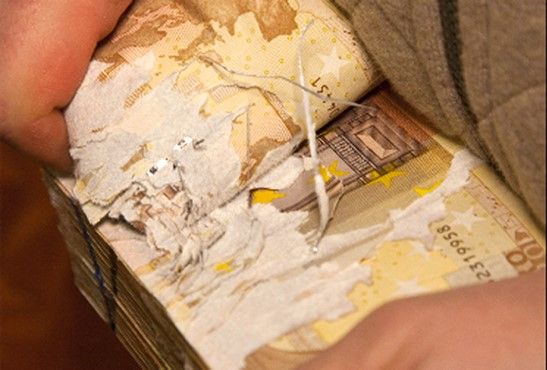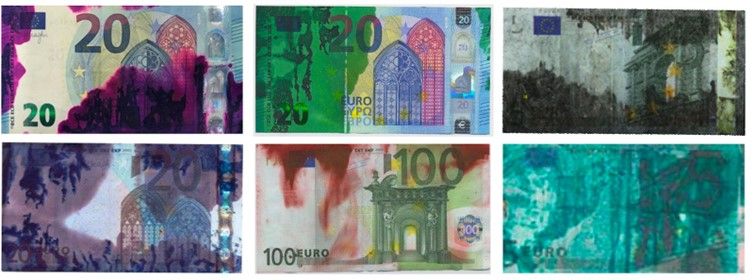
Ink-stained banknotes
Intelligent banknote neutralisation systems (IBNSs) are used in anti-theft devices, for example in ATMs or in the transport of banknotes in safes. Their purpose is to prevent theft or unauthorised access to banknotes. When a robbery is attempted or actually carried out, the banknotes are deliberately damaged in such a way as to become unusable as a means of payment, through staining with indelible ink. This reduces the risk of retailers, banks and other professional cash handlers falling victim to crime, and contributes to greater security and confidence in the system of banknote management.
How can you recognise banknotes damaged by an IBNS?
Various technologies are used in an IBNS. One of the most common involves systems that activate the explosive release of ink onto the banknotes, while a less common method glues the banknotes together.
The use of ink in an IBNS ensures that banknotes stained by the activation of the IBNS can be easily identified. The security inks that such systems use are spread onto and soak into the paper of the banknotes. Usually the edges of the banknotes are the most stained, with the ink gradually spreading to the centre of the note and creating a distinctive pattern (wave effect). The original colours of the most commonly used security inks are bright violet, green, blue, red or black.
Sometimes criminals try to wash the banknotes, but such attempts are usually unsuccessful. They use chemicals that should supposedly remove the security ink, but usually they just weaken it or change it to a different colour. Often an attempt to remove the security ink will result in damage to the security features that are built into the banknotes, which reduces the possibility of authenticating the notes as genuine.
Banknotes that have been stained by an IBNS have a recognisable colour and pattern of staining. Never accept such banknotes, since they are most probably stolen.
Photographs of ink-stained banknotes:
Glued banknotes
Some IBNSs are based on the use of strong and durable adhesive that glues the banknotes into a single wad. Individual notes cannot be unstuck without being torn into small pieces, which prevents their further use as a means of payment.
Photograph of banknotes glued together:

FAQs
Are all stained banknotes stolen?
No. If there are small stains or blotches on a banknote but not on the edge of the note, and if the edges of the banknote are undamaged, then it is most probable that the stains are not from an IBNS.
Examples of banknote stains not caused by an IBNS:
What should I do if someone offers me stained or bleached banknotes?
Hand the banknotes back and request others. The lawful owner of stained or bleached banknotes must bring them to Banka Slovenije themselves to replace them. Staining on banknotes can indicate that they were involved in a criminal offence where an IBNS was activated and disfigured the notes. Watch out also for bleached banknotes, since this can indicate an attempt to remove the stains caused by an IBNS.
What should I do if I have accepted stained banknotes?
Bring the banknotes to Banka Slovenije and explain how you obtained them. Banka Slovenije will then check to see if the banknotes were stained by an IBNS.
If it turns out that the banknotes were stained by an IBNS, you will not be entitled to exchange them. Banka Slovenije only exchanges such banknotes at the request of the original owner who was the victim of the crime that caused the banknotes to be stained by an IBNS. In the event of suspected criminal offence, the competent authorities (police) will be involved in further investigations.
If it turns out that the stains were not caused by an IBNS, you will be entitled to exchange them. You will receive new banknotes or your bank account will be credited with the value of the disfigured banknotes, on the condition that the banknotes are genuine.
What should I do if someone offers me glued banknotes?
Hand the banknotes back and request others. The lawful owner of glued banknotes must bring them to Banka Slovenije themselves to exchange them. Such banknotes were most probably glued together on activation of an IBNS during an attempted robbery or theft.


